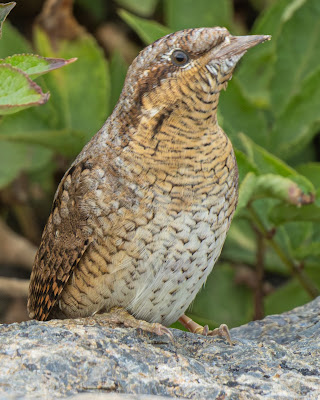 |
| Hudsonian Godwit |
Here then is my traditional year end review of my birding year.
The year of 2024 was definitely a case of “what a difference a year makes!” It certainly brought us all back down to earth after a truly stellar 2023. In the autumn of 2023 Lee, a truly monstrous storm sprawling across some 15,000 square miles of the Atlantic with winds up to 165mph, coincided with the mass migration of passerines along the west coast of north America. This almost unprecedented series of events delivered a large number of mega rare and UK first American passerines, mainly to the UK west coast, such that I managed to add a rather staggering 27 new birds to my UK life list. In contrast 2024 was notable for the almost total absence of American vagrants with the exception of a small number of birds early in the year, presumably leftover and undiscovered from the previous autumn. I managed just 13 new UK list additions in 2024 with the year largely saved by five new eastern Warblers. My annual autumn trip to Shetland delivering four of these.
Here are the thirteen 2024 additions to my UK list. If you click on the individual record it should take you to a blog article on that addition with more photos and background information.
· Northern Waterthrush, Essex, 4th January
· Sociable Lapwing, Cornwall 7th February
· Collared Flycatcher, Yorkshire, 4th May
· Indigo Bunting, Durham, 19th May
· Bridled Tern, Northumberland, 8th June
· Black-winged Pratincole, Yorkshire, 5th July
· Hudsonian Godwit, Cheshire, 13th August
· Pale Legged Warbler, Yorkshire, 1st October
· Eastern Crowned Warbler, Shetland, 3rd October
· Paddyfield Warbler, Shetland, 5th October
· Pallas’ Grasshopper Warbler, Shetland, 7th October
· Arctic Warbler, Shetland, 7th October
· Red-eyed Vireo, Dorset, 27th October
The year was also notable for a wonderful spring holiday with Carolyn in Tuscany. Waking up to the sound of Hoopoes calling in your garden is something you are unlikely to experience in the UK!
 |
| Italian Hoopoe |
Bird of the year
 |
| Pale-legged warbler curtsy of Nick Truby |
 |
| Pallas' Grasshopper Warbler |
In terms of one of my most wanted birds, the normally secretive and reclusive Pallas’ Grasshopper warbler , which spent a short time in Shetland in October, rates as a close runner up. This bird really is a Shetland speciality with precious few twitchable records on the UK mainland. Its habit of sulking in dense marshy terrain usually means that, if you are lucky, you may get the odd glimpse but on this occasion it showed quite well, all be it very briefly.
Photo of the year
 |
| Short-eared Owl |
 |
| Arctic Warbler |
As noted above, a close second was this pic of the autumn Arctic Warbler in Shetland. This it was a bird that I had previous history with having dipped twice before at Spurn in Yorkshire and on a previous trip to Shetland. I was actually twitching the Pallas’ Grasshopper Warbler (link)when news came in of this bird at a location previously unknown to me. It turned out to be a very short distance away from where I was staying in Scalloway. It was quite late in the afternoon when I arrived but it showed quite well in a small valley just off of the main road. I went back the next day and managed to get some much better pictures in better light as per the above shot.
 |
| Pallas' Leaf Warbler |
Also in the runners up I would include this picture of a Pallas’ Leaf Warbler again taken in October in Shetland. A beautifully tiny rare asian gem taken in perfect light!
Here is a small selection of other favourites from 2024.
 |
| Little Bunting |
 |
| Wryneck |
 |
| Baikal Teal |
 |
| Hawfinch |
 |
| Black Redstart |
 |
| Northern Water Thrush |
All that remains is for me to wish everyone who reads my blog a very happy Christmas and a bird filled 2025!
Cheers -Jim!
Great blog
ReplyDelete